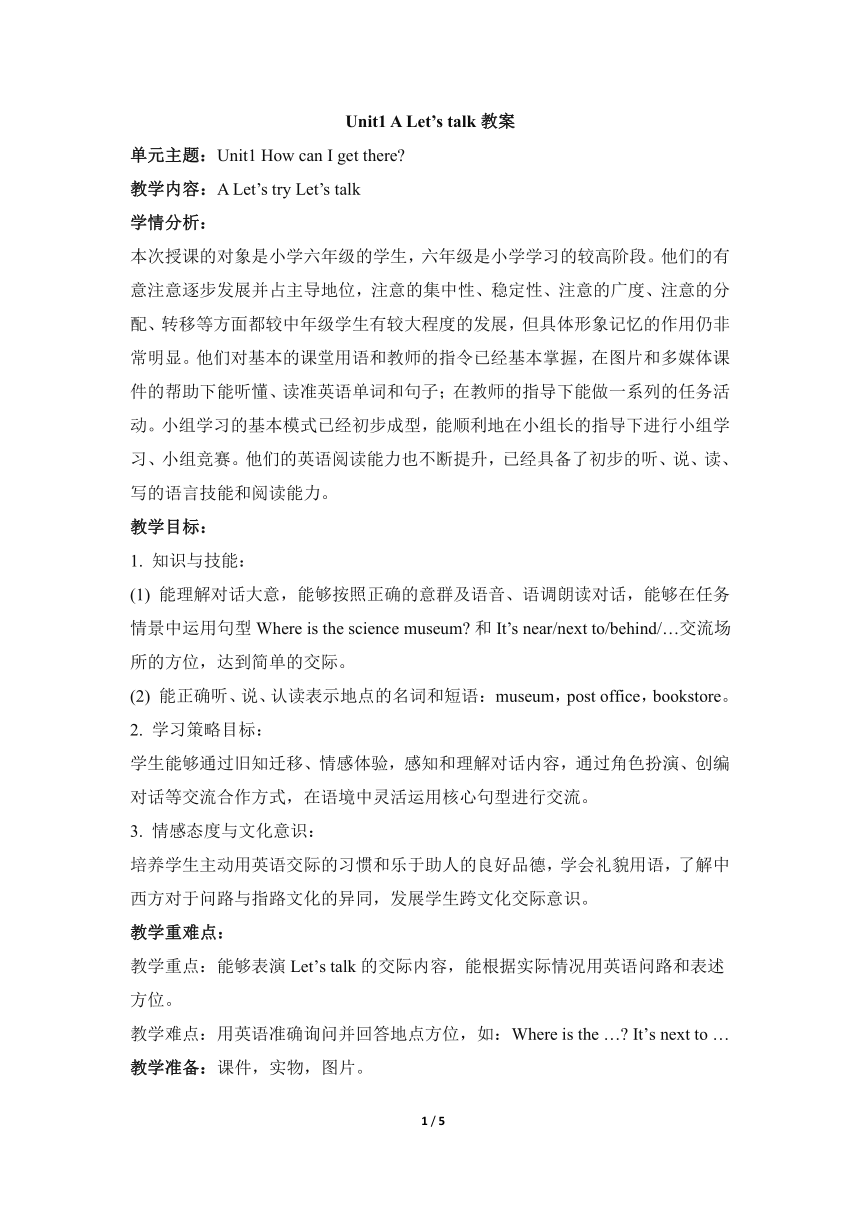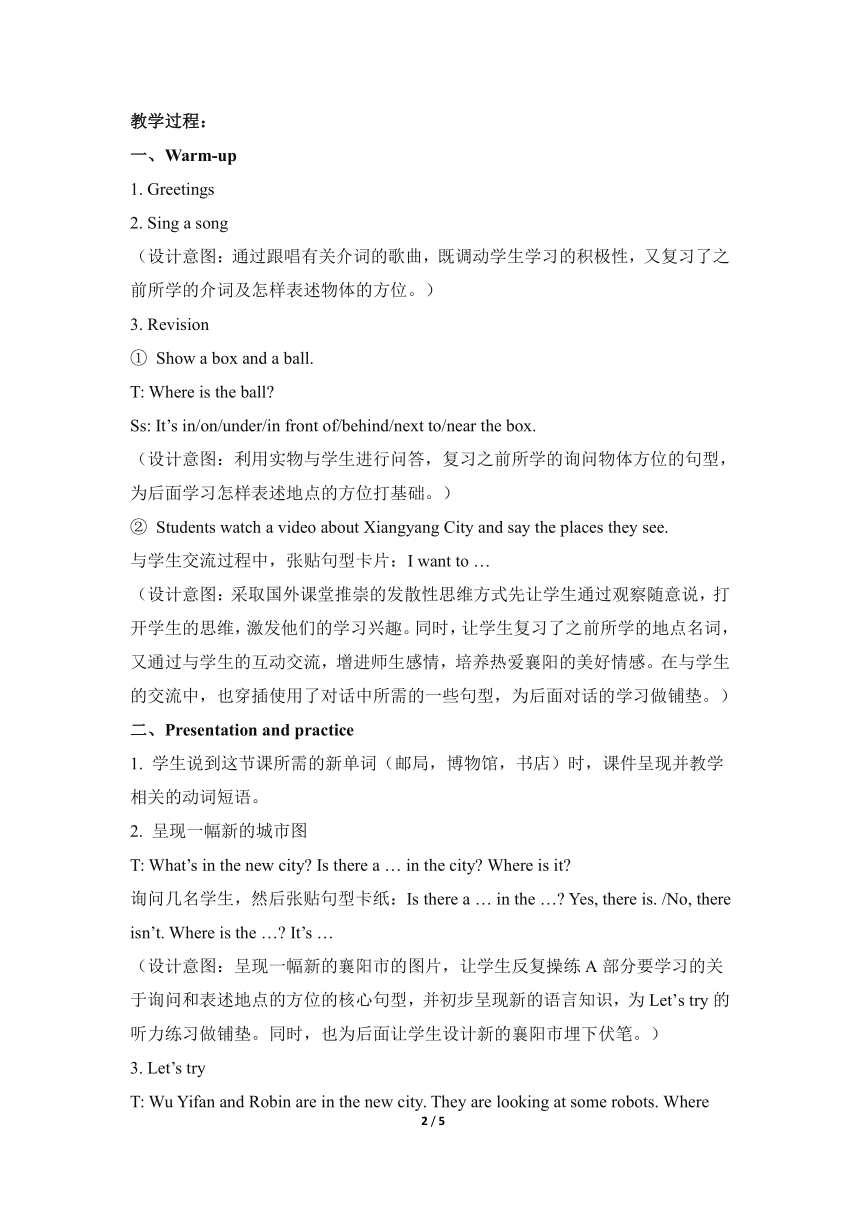Unit 1 How can I get there? A Let’s talk 教案
文档属性
| 名称 | Unit 1 How can I get there? A Let’s talk 教案 |  | |
| 格式 | zip | ||
| 文件大小 | 9.6KB | ||
| 资源类型 | 教案 | ||
| 版本资源 | 人教版(PEP) | ||
| 科目 | 英语 | ||
| 更新时间 | 2019-07-10 12:23:12 | ||
图片预览


文档简介
Unit1 A Let’s talk教案
单元主题:Unit1 How can I get there?
教学内容:A Let’s try Let’s talk
学情分析:
本次授课的对象是小学六年级的学生,六年级是小学学习的较高阶段。他们的有意注意逐步发展并占主导地位,注意的集中性、稳定性、注意的广度、注意的分配、转移等方面都较中年级学生有较大程度的发展,但具体形象记忆的作用仍非常明显。他们对基本的课堂用语和教师的指令已经基本掌握,在图片和多媒体课件的帮助下能听懂、读准英语单词和句子;在教师的指导下能做一系列的任务活动。小组学习的基本模式已经初步成型,能顺利地在小组长的指导下进行小组学习、小组竞赛。他们的英语阅读能力也不断提升,已经具备了初步的听、说、读、写的语言技能和阅读能力。
教学目标:
1. 知识与技能:
(1) 能理解对话大意,能够按照正确的意群及语音、语调朗读对话,能够在任务情景中运用句型Where?is?the?science?museum??和It’s near/next to/behind/…交流场所的方位,达到简单的交际。
(2) 能正确听、说、认读表示地点的名词和短语:?museum,post?office,bookstore。
2. 学习策略目标:
学生能够通过旧知迁移、情感体验,感知和理解对话内容,通过角色扮演、创编对话等交流合作方式,在语境中灵活运用核心句型进行交流。
3. 情感态度与文化意识:?
培养学生主动用英语交际的习惯和乐于助人的良好品德,学会礼貌用语,了解中西方对于问路与指路文化的异同,发展学生跨文化交际意识。
教学重难点:
教学重点:能够表演Let’s?talk?的交际内容,能根据实际情况用英语问路和表述方位。 教学难点:用英语准确询问并回答地点方位,如:Where?is?the?…??It’s?next?to …
教学准备:课件,实物,图片。
教学过程:
一、Warm-up
1. Greetings
2. Sing a song
(设计意图:通过跟唱有关介词的歌曲,既调动学生学习的积极性,又复习了之前所学的介词及怎样表述物体的方位。)
3. Revision
① Show a box and a ball.
T: Where is the ball?
Ss: It’s in/on/under/in front of/behind/next to/near the box.
(设计意图:利用实物与学生进行问答,复习之前所学的询问物体方位的句型,为后面学习怎样表述地点的方位打基础。)
② Students watch a video about Xiangyang City and say the places they see.
与学生交流过程中,张贴句型卡片:I want to …
(设计意图:采取国外课堂推崇的发散性思维方式先让学生通过观察随意说,打开学生的思维,激发他们的学习兴趣。同时,让学生复习了之前所学的地点名词,又通过与学生的互动交流,增进师生感情,培养热爱襄阳的美好情感。在与学生的交流中,也穿插使用了对话中所需的一些句型,为后面对话的学习做铺垫。)
二、Presentation and practice
1. 学生说到这节课所需的新单词(邮局,博物馆,书店)时,课件呈现并教学
相关的动词短语。
2. 呈现一幅新的城市图
T: What’s in the new city? Is there a … in the city? Where is it?
询问几名学生,然后张贴句型卡纸:Is there a … in the …? Yes, there is. /No, there isn’t. Where is the …? It’s …
(设计意图:呈现一幅新的襄阳市的图片,让学生反复操练A部分要学习的关于询问和表述地点的方位的核心句型,并初步呈现新的语言知识,为Let’s try的听力练习做铺垫。同时,也为后面让学生设计新的襄阳市埋下伏笔。)
3. Let’s try
T: Wu Yifan and Robin are in the new city. They are looking at some robots. Where
are they now? Please listen and tick.
Have students try to guess the answers. Then have them listen and check the answers.
T: Grandpa isn’t there. How do you know that?
Show the conversation and find the sentence: Don’t forget to buy gifts for grandpa.
(设计意图:教材中的练习的第一小题,我把书本中的两个选项增加到了四个。
补充两个已学词组作为同类选项,有利于学生理解文本。在此环节最后,呈现了
整个文本,帮助学生理解第二个问题Is Grandpa there?)
4. Let’s talk
① T: What does Wu Yifan want to buy? Please listen and find the answer.
Then students listen and check the answer.
(设计意图:这个问题在此起到了承上启下的作用。让学生带着疑问去听,帮助
学生初步了解对话大意,,有目的地去寻找所需要的信息,同时也培养了学生专
注地听的能力。)
② T: Where can he buy the postcard and send it? Please watch the video and fill in
the blanks.
(设计意图:设置第二梯度的问题,引导学生带着问题听录音,一步步理解文意,
迅速抓住要点并进行归纳总结。但这次以填空的形式出现,也增加了学生的新鲜
感。)
③ T: But where is the museum shop and where is the post office? Please read let’s
talk and try to put the word cards with museum shop and post office on the right
place.
(设计意图:学生自读课文,把post office和museum shop贴在黑板上相应的建
筑物上,以此来获取文本的核心信息)
After putting up “museum shop”:
T: Who tells us?
Ss: Robin. Robin says: It’s near the door.
T: Oh, Robin can talk. He is a talking robot.
T: Where is the post office? Does Robin know?
Ss: No.
T: How do you know that?
Guide students to say: Robin says “I don’t know. I’ll ask.”
After putting up “post card”:
T: What does the man think of the museum?
Ss: He thinks it’s a great museum!
T: Why does the man think so?
Ss: Because he thinks Robin is the robot in the museum.
T: But Robin is not the robot in the museum. He is just visiting the museum.
(设计意图:在学生完成任务、理解对话的同时,穿插击破各个重难点新词句。)
④ Have students listen and repeat.
(设计意图:通过模仿原声带和朗读,提高学生口语能力,既帮助学生增强对词汇和语言结构的记忆,又增强学生的语感。)
⑤ Have students read in groups of three. Then act.
⑥ The students are divided into three groups to read the dialogue.
(设计意图:通过分组读以及表演对话等多种形式让学生理解对话、熟悉对话,
理解本课意群。)
三、Consolidation and extension
1. Make a new dialogue
Show a conversation which is similar to the dialogue in the book and have students
try to make a new conversation.
Then pick several groups to act it out.
(设计意图:通过掏空句子的形式,有意识地引导学生运用所学的语言知识重塑文本,培养学生的创新能力和交际能力。)
2. 小小设计师“Who is the best designer?”
Have students put up the pictures they collected to design a new Xiangyang city.
After that, have students come to the front and make a report about their cities.
At last, choose the best designer.
(设计意图:小小设计师的活动为学生提供运用目标语言在语境中进行交际的机
会,并要求学生进行总结汇报,提供给学生拓展运用语言的空间,培养团结合作
的精神。同时,也培养了学生热爱家乡的美好情感。)
四、Summary and assessment
This lesson, we have learnt some important sentences, like “I want to … Where is …? It’s …”. We should try to use them to ask the way and give directions.
五、Homework
1. Have students write the report.
2. Have students talk about the places in Xiangyang City with their partners in English.
(设计意图:通过与别人用英语交流,巩固本节课的语言知识,并培养了交际能力。通过写强化所学的语言知识。)
六、板书
Unit1 How can I get there?
Ask the way Give directions
Excuse me.
I want to …
bookstore
Where is the …? post office It’s next to / near …
museum shop
单元主题:Unit1 How can I get there?
教学内容:A Let’s try Let’s talk
学情分析:
本次授课的对象是小学六年级的学生,六年级是小学学习的较高阶段。他们的有意注意逐步发展并占主导地位,注意的集中性、稳定性、注意的广度、注意的分配、转移等方面都较中年级学生有较大程度的发展,但具体形象记忆的作用仍非常明显。他们对基本的课堂用语和教师的指令已经基本掌握,在图片和多媒体课件的帮助下能听懂、读准英语单词和句子;在教师的指导下能做一系列的任务活动。小组学习的基本模式已经初步成型,能顺利地在小组长的指导下进行小组学习、小组竞赛。他们的英语阅读能力也不断提升,已经具备了初步的听、说、读、写的语言技能和阅读能力。
教学目标:
1. 知识与技能:
(1) 能理解对话大意,能够按照正确的意群及语音、语调朗读对话,能够在任务情景中运用句型Where?is?the?science?museum??和It’s near/next to/behind/…交流场所的方位,达到简单的交际。
(2) 能正确听、说、认读表示地点的名词和短语:?museum,post?office,bookstore。
2. 学习策略目标:
学生能够通过旧知迁移、情感体验,感知和理解对话内容,通过角色扮演、创编对话等交流合作方式,在语境中灵活运用核心句型进行交流。
3. 情感态度与文化意识:?
培养学生主动用英语交际的习惯和乐于助人的良好品德,学会礼貌用语,了解中西方对于问路与指路文化的异同,发展学生跨文化交际意识。
教学重难点:
教学重点:能够表演Let’s?talk?的交际内容,能根据实际情况用英语问路和表述方位。 教学难点:用英语准确询问并回答地点方位,如:Where?is?the?…??It’s?next?to …
教学准备:课件,实物,图片。
教学过程:
一、Warm-up
1. Greetings
2. Sing a song
(设计意图:通过跟唱有关介词的歌曲,既调动学生学习的积极性,又复习了之前所学的介词及怎样表述物体的方位。)
3. Revision
① Show a box and a ball.
T: Where is the ball?
Ss: It’s in/on/under/in front of/behind/next to/near the box.
(设计意图:利用实物与学生进行问答,复习之前所学的询问物体方位的句型,为后面学习怎样表述地点的方位打基础。)
② Students watch a video about Xiangyang City and say the places they see.
与学生交流过程中,张贴句型卡片:I want to …
(设计意图:采取国外课堂推崇的发散性思维方式先让学生通过观察随意说,打开学生的思维,激发他们的学习兴趣。同时,让学生复习了之前所学的地点名词,又通过与学生的互动交流,增进师生感情,培养热爱襄阳的美好情感。在与学生的交流中,也穿插使用了对话中所需的一些句型,为后面对话的学习做铺垫。)
二、Presentation and practice
1. 学生说到这节课所需的新单词(邮局,博物馆,书店)时,课件呈现并教学
相关的动词短语。
2. 呈现一幅新的城市图
T: What’s in the new city? Is there a … in the city? Where is it?
询问几名学生,然后张贴句型卡纸:Is there a … in the …? Yes, there is. /No, there isn’t. Where is the …? It’s …
(设计意图:呈现一幅新的襄阳市的图片,让学生反复操练A部分要学习的关于询问和表述地点的方位的核心句型,并初步呈现新的语言知识,为Let’s try的听力练习做铺垫。同时,也为后面让学生设计新的襄阳市埋下伏笔。)
3. Let’s try
T: Wu Yifan and Robin are in the new city. They are looking at some robots. Where
are they now? Please listen and tick.
Have students try to guess the answers. Then have them listen and check the answers.
T: Grandpa isn’t there. How do you know that?
Show the conversation and find the sentence: Don’t forget to buy gifts for grandpa.
(设计意图:教材中的练习的第一小题,我把书本中的两个选项增加到了四个。
补充两个已学词组作为同类选项,有利于学生理解文本。在此环节最后,呈现了
整个文本,帮助学生理解第二个问题Is Grandpa there?)
4. Let’s talk
① T: What does Wu Yifan want to buy? Please listen and find the answer.
Then students listen and check the answer.
(设计意图:这个问题在此起到了承上启下的作用。让学生带着疑问去听,帮助
学生初步了解对话大意,,有目的地去寻找所需要的信息,同时也培养了学生专
注地听的能力。)
② T: Where can he buy the postcard and send it? Please watch the video and fill in
the blanks.
(设计意图:设置第二梯度的问题,引导学生带着问题听录音,一步步理解文意,
迅速抓住要点并进行归纳总结。但这次以填空的形式出现,也增加了学生的新鲜
感。)
③ T: But where is the museum shop and where is the post office? Please read let’s
talk and try to put the word cards with museum shop and post office on the right
place.
(设计意图:学生自读课文,把post office和museum shop贴在黑板上相应的建
筑物上,以此来获取文本的核心信息)
After putting up “museum shop”:
T: Who tells us?
Ss: Robin. Robin says: It’s near the door.
T: Oh, Robin can talk. He is a talking robot.
T: Where is the post office? Does Robin know?
Ss: No.
T: How do you know that?
Guide students to say: Robin says “I don’t know. I’ll ask.”
After putting up “post card”:
T: What does the man think of the museum?
Ss: He thinks it’s a great museum!
T: Why does the man think so?
Ss: Because he thinks Robin is the robot in the museum.
T: But Robin is not the robot in the museum. He is just visiting the museum.
(设计意图:在学生完成任务、理解对话的同时,穿插击破各个重难点新词句。)
④ Have students listen and repeat.
(设计意图:通过模仿原声带和朗读,提高学生口语能力,既帮助学生增强对词汇和语言结构的记忆,又增强学生的语感。)
⑤ Have students read in groups of three. Then act.
⑥ The students are divided into three groups to read the dialogue.
(设计意图:通过分组读以及表演对话等多种形式让学生理解对话、熟悉对话,
理解本课意群。)
三、Consolidation and extension
1. Make a new dialogue
Show a conversation which is similar to the dialogue in the book and have students
try to make a new conversation.
Then pick several groups to act it out.
(设计意图:通过掏空句子的形式,有意识地引导学生运用所学的语言知识重塑文本,培养学生的创新能力和交际能力。)
2. 小小设计师“Who is the best designer?”
Have students put up the pictures they collected to design a new Xiangyang city.
After that, have students come to the front and make a report about their cities.
At last, choose the best designer.
(设计意图:小小设计师的活动为学生提供运用目标语言在语境中进行交际的机
会,并要求学生进行总结汇报,提供给学生拓展运用语言的空间,培养团结合作
的精神。同时,也培养了学生热爱家乡的美好情感。)
四、Summary and assessment
This lesson, we have learnt some important sentences, like “I want to … Where is …? It’s …”. We should try to use them to ask the way and give directions.
五、Homework
1. Have students write the report.
2. Have students talk about the places in Xiangyang City with their partners in English.
(设计意图:通过与别人用英语交流,巩固本节课的语言知识,并培养了交际能力。通过写强化所学的语言知识。)
六、板书
Unit1 How can I get there?
Ask the way Give directions
Excuse me.
I want to …
bookstore
Where is the …? post office It’s next to / near …
museum shop
同课章节目录
